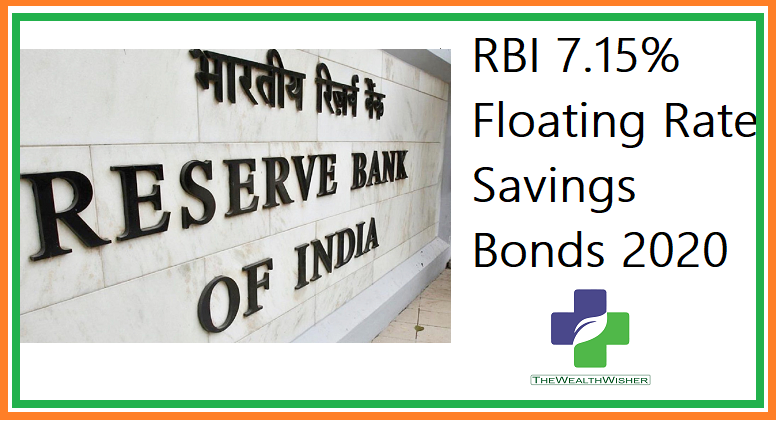Finally, the Government made amendments to Personal Finance Investors. They had closed RBI bonds on a Saturday, just giving half-day (Monday) to build panic among fixed-income investors. And almost a month after they have launched the improvised version – RBI 7.15% Floating Rate Savings Bonds 2020. These RBI Bonds start for subscription from July 01, 2020.
What are the features of RBI Floating Rate Savings Bonds? Should you invest? What is “Floating” in RBI 7.15% Floating Rate Savings Bonds? Who can invest? Let see in today’s post:
RBI 7.15% Floating Rate Savings Bonds 2020
These bonds have been launched in place the earlier withdrawn from 7.75% RBI bonds. The previous version offered 7.75% RBI bonds offered a fixed interest rate for the tenure of the bonds. You can also interest on a cumulative basis. The new bonds disappoint on these very basic features. Many features are the same as the closed bonds. Let’s check-in details.
RBI 7.15% Floating Rate Savings Bonds 2020 Features
 Face Value: Rs 100 Per Bond
Face Value: Rs 100 Per Bond
Minimum Investment: 10 Bonds (Rs 1000)
Maximum Investment: No Limit
Who can Invest?
- Residents Individuals in single or joint holding mode (max 3 holders).
- Minors under the guardianship of their parents.
- HUFs
- NRI & Institutions cannot invest in these Bonds.
What is the Rate of Interest RBI 7.15% Floating Rate Savings Bonds 2020?
It starts at 7.15%. The rate will be revised every six months. Hence the bonds are called “Floating Rate” bonds. The first reset date is January 01, 2021. Then every 1 Jan & 1 July of the year.
There is no option to pay interest on a cumulative basis i.e. interest will be payable every six months ie 30 June & 31 December every year.
What is the tenure & lock-in period for RBI 7.15% Floating Rate Savings Bonds 2020?
The tenure of bonds is 7 Years.
Investors below the age of 60 will have no exit feature. This means they have to keep the bond to maturity only.
Lock-in period for the holder in the age bracket 60 to 70 years will be 6 years. Similarily for age, 70 to 80 lock-in will be 5 years and above 80 years it will be 4 years.
Smart TIP: Include a member above 60 Years or 80 Years as a second or third holder. Then your bond also can have a premature facility. This is because the guideline says – If any holder (first or second or third) fulfills the age criteria, the bond can be prematurely withdrawn.
Nomination
The bond has a nomination facility. The nomination can also be changed or altered during the bond tenure.
Other points to remember
- The bonds come in electronic form and held at the credit of the holder in an account called Bond Ledger Account, opened with the Receiving Office.
- Investment in these bonds will be in the form of cash (up to Rs 20,000)/drafts/cheques or any electronic mode acceptable to the Receiving Office.
- Applications for the bonds in the form of Bond Ledger Account will be received in the designated branches of SBI, Nationalised banks, IDBI Bank, Axis Bank, HDFC Bank, and ICICI Bank.
- These RBI 7.15% Floating Rate Savings Bonds 2020 bonds are taxable.
- The bonds will attract TDS as applicable.
- You cannot offer these bonds as collateral for loans from banks, financial institutions, NBFCs, etc.
- RBI Floating Rate Savings Bonds are not eligible for trading in the secondary market.
- The bonds are not transferable except transfer to a nominee(s)/legal heir in case of death of the holder of the bonds.
- The interest will also be paid electronically in the account of the first holder.
- RBI may allow other entities to act as representatives. Earlier SHCIL (Stock Holding Corporation of India) was authorized. This time it is not clear about this institution. I may add up later.

Should you invest in RBI Floating Rate Savings Bonds?
Positives: The bond is 100% risk-free as they are backed by RBI. If you are looking for the utmost safety, these bonds are fully eligible. Currently, Bank FDs (including Senior Citizen FDs) are yielding below 7.15% rate. Hence it looks attractive. Investors looking at fixed returns every six month can invest in these bonds. Many government-backed schemes like (SCSS & PMVVY & Post Office schemes) have upper limits of investments. These bonds have no upper limit to invest.
Negatives: The interest rate is not fixed. So if the interest rate keeps decreasing the rate will further decrease. Bonds also have very little liquidity and non-transferable. So it is a buy and hold for a long period type of investment. Investors other than a senior citizen cannot withdraw or sell in stock exchange in emergencies. Interest received is taxable and contributions are also not eligible for deduction under Income tax.
Do contact us for further information on these bonds through the comments section below. Let us know what you think.








